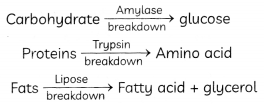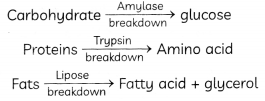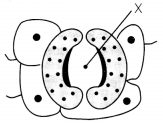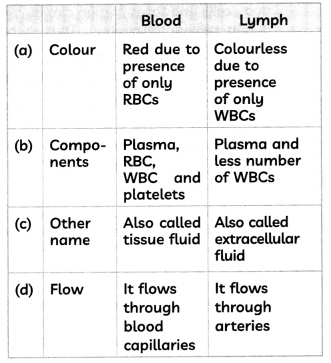Life Processes Class 10 MCQs Questions with Answers
Question 1.
If salivary amylase is lacking in the saliva, which of the following events in the mouth cavity wilL be affected?
(a) Proteins breaking down into amino acids
(b) Starch breaking down into sugars
(c) Fats breaking down into fatty acids and glycerol
(d) Absorption of vitamins
Answer:
(b) Starch breaking down into sugars
Explanation: The process of digestion begins in the mouth. The mouth contains a digestive enzyme, salivary amylase. This enzyme breaks the starch molecules in the food, into maltose. The absence of amylase in the saliva thus affects the breakdown of starch into simpler sugar molecules.
Question 2.
In the excretory system of human beings, some substances in the initial filtrate such as glucose, amino acids, salts and water are selectively reabsorbed in:
(a) Urethra
(b) Nephron
(c) Ureter
(d) Urinary bladder
Answer:
(b) Nephron.
Explanation: A nephron is a filtering unit present in kidney. It has different parts like Bowman’s capsule, glomerulus and tubuLar region (Renal tubule). Glucose, amino acids and salts are selectively reabsorbed in tubular region.
Question 3.
Which part of alimentary canal receives bile from the liver?
(a) Stomach
(b) Small intestine
(c) Large intestine
(d) Oesophagus
Answer:
(b) Small intestine
Explanation: Bile is secreted by the liver and is stored in the gall bladder from where it enters the small intestine via a common duct.
Related Theory
It performs two functions:
- makes the food alkaline.
- breaks the fats present in food into small globules by the process of emulsification.
Question 4.
Pseudopodia are:
(a) small hair-like structures present on unicellular organisms.
(b) false feet developed in some unicellular organisms.
(c) long, tube-like structures coming out of the mouth.
(d) suckers which are attached to the walls of the intestines.
Answer:
Question 5.
A few drops of iodine solution were added to rice water. The solution turned blue-black in colour. This indicates that the rice water contains:
(a) Complex proteins
(b) Simple proteins
(c) Fats
(d) Starch
Answer:
(d) Starch
Explanation: Iodine solution is often used for testing the presence of starch in the food particles. When iodine is added to starch, it turns blue-black. Rice water contains starch, hence when iodine solution is added to rice water it turns blue-black.
Question 6.
which one of the following statements is correct about the human circulatory system?
(a) Blood transports only oxygen and not carbon dioxide.
(b) Human heart has five chambers.
(c) Valves ensure that the blood does not flow backwards.
(d) Both oxygen-rich and oxygen-deficient blood gets mixed in the heart.
Answer:
Question 7.
Anaerobic process:
(a) takes place in yeast during fermentation.
(b) takes place in the presence of oxygen.
(c) produces only energy in the muscles of human beings.
(d) produces ethanol, oxygen and energy.
Answer:
(a) takes place in yeast during fermentation.
Explanation: (a) Anaerobic respiration (in absence of oxygen) in yeast is known as fermentation as ethanol (alcohol) carbon dioxide and 2 ATP molecules of energy is produced from glucose.
![]()
carbon dioxide + 2 ATP molecules of energy
(b) Aerobic respiration takes place in presence of oxygen and anaerobic in absence of oxygen.
(c) In muscles of human beings: Lack of oxygen or absence of oxygen results into the formation of lactic acid and very less amount of energy.
(d) Ethanol and carbon dioxide are produced. Energy is neither produced nor released.
Question 8.
When air is blown from mouth into a test tube containing Lime water, the lime water turns milky due to the presence of
(a) Oxygen
(b) Carbon dioxide
(c) Nitrogen
(d) Water vapour
Answer:
Question 9.
Most of the digestion and absorption of the food takes place in the:
(a) small intestine
(b) liver
(c) stomach
(d) large intestine
Answer:
(a) small intestine.
Explanation: Small intestine receives juices from liver, pancreas and walls of small intestine. Bite juice from liver emulsifies the fats and makes the medium alkaline. Pancreas and small intestine juices contain amylase, lipase and tryspin.
The function of these enzymes ore:

Question 10.
Which of the foL[owing statement (s) is (are) true about respiration?
(I) During inhalation ribs move inward and the diaphragm is raised.
(II) In the alveoli, the exchange of gases takes place i.e. oxygen from alveolar air diffuses into bLood and carbon dioxide from the blood into the alveolar air.
(III) Haemoglobin has a greater affinity for carbon dioxide than oxygen.
(IV)Atveoti increases surface area for the exchange of gases.
(a) (I) and (IV)
(b) (II) and (III)
(c) (I) and (III)
(d) (II) and (IV)
Answer:
Question 11.
Which is the correct sequence of air passage during inhalation?
(a) Nostrils → Larynx → Pharynx → Trachea → Lungs
(b) Nasal passage → Trachea → Pharynx → Larynx → Alveoli
(c) Larynx → Nostrils → Pharynx → Lungs
(d) Nostrils → Pharynx → Larynx → Trachea → Alveoli
Answer:
(d) Nostrils → Pharynx → Larynx → Trachea → Alveoli
Question 8.
When air is blown from mouth into a test tube containing lime water, the lime water turns milky due to the presence of:
(a) Oxygen
(b) Carbon dioxide
(c) Nitrogen
(d) Water vapour
Answer:
Question 9.
Most of the digestion and absorption of the food takes place in the:
(a) small intestine
(b) liver
(c) stomach
(d) large intestine
Answer:
(a) small intestine.
Explanation: Small intestine receives juices from liver, pancreas and walls of small intestine. Bile juice from liver emulsifies the fats and makes the medium alkaline. Pancreas and small intestine juices contain amylase, lipase and tryspin.
The function of these enzymes are:

Question 10.
Which of the following statement (s) is (are) true about respiration?
(I) During inhalation, ribs move inward and diaphragm is raised.
(II) In the alveoli, exchange of gases takes place i.e. oxygen form alveolar air diffuses into blood and carbon dioxide from blood into alveolar air.
(III) Haemoglobin has greater affiinity for carbon dioxide than oxygen.
(IV) Alveoli increases surface area for exchange of gases.
Answer:
Question 12.
During respiration, the exchange of gases take place in:
(a) Trachea and Larynx
(b) Alveoli of lungs
(c) Alveoli and throat
(d) Throat and larynx
Answer:
Question 13.
Single circulation, i.e., blood flows through the heart only once during one cycle of passage through the body, is exhibited by:
(a) Labeo, Chameleon, Salamander
(b) Hippocampus, Exocoetus, Anabas
(c) Hyla, Rana, Draco
(d) whale, dolphin, turtle
Answer:
(b) Hippocampus, Exocoetus, Anabas
Explanation: Fishes have two-chambered heart and exhibit single circulation, while three-chambered heart of amphibians and reptiles and four-chambered heart of birds and mammals exhibit double circulation.
Question 14.
In which of the following vertebrate group/ groups, does heart not pump oxygenated blood to different parts of the body?
(a) Pisces and amphibians
(b) Amphibians and reptiles
(c) Amphibians only
(d) Pisces only
Answer:
(d) Pisces only
Explanation: Fishes have only two-chambered heart and the blood is pumped to the gills, is oxygenated there, and passes directly to the rest of the body. Thus, blood goes only once through the heart in the fish during one cycle of passage through the body. Fishes take in water through their mouths and force it past the gills where the dissolved oxygen is taken up by blood.
Question 15.
Which of the following statements about the autotrophs is incorrect:
(a) They synthesize carbohydrates from carbon dioxide and water in the presence of sunlight and chlorophyll
(b) They store carbohydrates in the form of starch
(c) They convert carbon dioxide and water into carbohydrates in the absence of sunlight
(d) They constitute the first trophic level in food chains
Answer:
(c) They convert carbon dioxide and water into carbohydrates in the absence of sunlight Explanation: Autotrophs obtain the required carbon and energy requirements from carbon dioxide and Sunlight. They combine carbon dioxide and water to form carbohydrates.
Question 16.
Oxygen liberated during photosynthesis comes from:
(a) Water
(b) Chlorophyll
(c) Carbon dioxide
(d) Glucose
Answer:
Question 17.
The blood leaving the tissues becomes richer in:
(a) Carbon dioxide
(b) Water
(c) Haemoglobin
(d) Oxygen
Answer:
(a) Carbon dioxide
Explanation: The blood leaving the tissues becomes richer in carbon dioxide. When the oxygenated blood passes through the capillaries of the tissue, it gives oxygen to the body cells and takes carbon dioxide, produced during cellular respiration. Thus, it becomes richer in carbon dioxide.
Question 18.
The xylem in plants are responsible for:
(a) Transport of water
(b) Transport of food
(c) Transport of amino acids
(d) Transport of oxygen
Answer:
(a) Transport of water
Explanation: Xylem tissues include tracheids, vessels, fibres and parenchyma and serve in the ascent of sap/water and minerals.
Related Theory
Phloem tissues comprised of four elements: sieve, companion cell, phloem fibres and phloem parenchyma. They serve in the translocation of organic nutrients.
Question 19.
Which of the following is an incorrect statement?
(a) Organisms grow with time.
(b) Organisms must repair and maintain their structure.
(c) Movement of molecules does not take place among cells.
(d) Energy is essential for life processes.
Answer:
Question 20.
The internal (cellular) energy reserve in autotrophs is:
(a) Glycogen
(b) Protein
(c) Starch
(d) Fatty acid
Answer:
(c) Starch
Explanation: The food prepared in the plant (autotrophs) by the process of photosynthesis is glucose that gets stored in various plant parts in the form of starch.
Question 21.
Choose the event that does not occur in photosynthesis.
(a) Absorption of light energy by chlorophyll
(b) Reduction of carbon dioxide to carbohydrates
(c) Oxidation of carbon to carbon dioxide
(d) Conversion of light energy to chemical energy
Answer:
Question 22.
Choose the forms in which most plants absorb nitrogen:
(I) Proteins
(II) Nitrates and Nitrites
(III) Urea
(IV) Atmospheric nitrogen
(a) (I) and (II)
(b) (II) and (III)
(c) (III) and (IV)
(d) (I) and (IV)
Answer:
Question 23.
The doctor measured Ravi’s blood pressure and said it is normal now. The range of Ravi’s blood pressure (systolic/diastolic) is likely to be:
(a) \(\frac{120}{80}\) mm of Hg
(b) \(\frac{160}{80}\) mm of Hg
(c) \(\frac{120}{60}\) mm of Hg
(d) \(\frac{180}{80}\) mm of Hg
Answer:
(a) \(\frac{120}{80}\) mm of Hg
Explanation: Blood pressure is denoted by two values: one value is above and the other value
is below. The value that is above is the systolic pressure and the one that is below is the diastolic pressure. A normal individual should maintain a systolic/diastolic pressure of \(\frac{120}{80}\) mm of Hg.
Related Theory
Blood pressure is the force applied by the blood against the walls of the arteries. The blood pressure is of two types – systolic and diastolic. The blood pressure of a normal individual is 120/80 mm ofHg. If a person has less blood pressure than normal, he/ she is said to have low blood pressure.
If a person has more blood pressure than normal, he/ she is said to have high blood pressure.
Question 24.
If the structure marked X in the diagram given below is blocked, then which of the processes will not occur?

(a) Transpiration and respiration
(b) Transpiration, photosynthesis and respiration
(c) Respiration, transpiration and transportation
(d) Respiration and photosynthesis [Diksha]
Answer:
(b) Transpiration, photosynthesis and respiration Explanation: Here, the structure marked as X is stomata.
Stomata are responsible for gaseous exchange in the plant. If they are blocked, the gaseous exchange will not take place.
Hence, the two important processes of the plant: photosynthesis and respiration do not take place. Stomata are also responsible for removing extra water present in the plants.
Hence, if blocked, the process of transpiration will also be affected.
Question 25.
Which of the following statement(s) is incorrect about transport in plants:
(I) The transport in the xylem is achieved by utilizing energy.
(II) Transpiration helps in the absorption of water and minerals from the roots to the leaves.
(III) The transport of soluble products of photosynthesis occurs in the phloem.
(IV) Besides water, the xylem also transports amino acids and other substances.
(a) Both (I) and (III)
(b) Both (II) and (III)
(c) Both (I) and (IV)
(d) Both (III) and (IV)
Answer:
(c) Both (I) and (IV)
Explanation: Transport of water and minerals in xylem takes place by the process of osmosis due to difference in ionic concentration in the soil and inside the root. Transpiration pull helps in the absorption of water to the taller parts of a plant during the daytime when the stomata are open. The phloem transports the soluble products of photosynthesis, amino acids and some other substances.
Question 26.
Which of the following statements are incorrect about aerobic respiration?
(I) The first step is the breakdown of glucose into pyruvate.
(II) Glucose is a six-carbon molecule and pyruvate is a three-carbon molecule.
(III) The breakdown of glucose take place in the mitochondria.
(IV) The breakdown of pyruvate using oxygen takes place in the cytoplasm.
(a) Both (I) and (III)
(b) Both (II) and (IV)
(c) Both (III) and (IV)
(d) (I), (III) and (IV)
Answer:
Question 27.
A student noted the differences between blood and lymph in the following table. Select the row containing correct information:

Answer:
(d) Blood: It flows through blood capillaries: Lymph: It flows through arteries
Explanation: Lymph drains into Lymph capillaries from the intercellular spaces which join to form large lymph vesseLs that finally open into larger veins.
Question 28.
Select the incorrect statement from the statements given below.
Waste products in plants:
(a) Are stored in the Golgi apparatus.
(b) Are stored in leaves that fall off.
(c) Are stored as resins and gums, especially in old xylem.
(d) Are excreted into the soil around them.
Answer:
(a) Are stored in the Golgi apparatus.
Question 29.
Which of the following part of the human excretory system is under nervous control?
(a) Ureters
(b) Urethra
(c) Urinary bladder
(d) Collecting duct
Answer:
(c) Urinary bladder
Explanation: The urinary bladder is a muscular structure that stores the urine until we get the urge to urinate. It is under nervous control.
Question 30.
In humans, the oxygen-rich blood from the lungs comes to the:
(a) Left atrium.
(b) Right atrium
(c) Left ventricle
(d) Right ventricle
Answer:
Question 31.
Select the incorrect statement:
(a) The arteries have thick, elastic walls
(b) The veins have thin walls
(c) Veins have valves to ensure that blood flows in one direction only.
(d) Arteries have valves to ensure that blood flows in one direction only.
Answer:
(d) Arteries have valves to ensure that blood flows in one direction only.
Explanation: Arteries do not have any valves as they carry blood away from the heart. They have thick and elastic walls as they bLood is under high pressure. Veins have valves to ensure that the blood flows in one direction only.
Assertion Reasoning questions Class 10 Science Chapter 6
For the following questions two statements are given- one labeled Assertion (A) and the other labeled Reason (R). Select the correct answer to these questions from the codes (a), (b), (c) and (d) as given below:
(a) Both (A) and (R) are true and (R) is correct explanation of the assertion.
(b) Both (A) and (R) are true but R is not the correct explanation of the assertion.
(c) (A) is true but (R) is false.
(d) (A) is false but (R) is true.
Question 32.
Assertion (A): Transpiration cools leaf surface.
Reason (R): Transpiration helps in translocation of sugar in plants. [Diksha]
Answer:
(c) (A) is true but (R) is false.
Explanation: Transpiration is the process by which plants lose extra water off their surface with the help of the stomata of the Leaves. The plants usually lose water during very hot season. As a result, the temperature of the plant decreases and it cools down. However, transpiration does not help in translocation of food in the plants. Therefore, the assertion is true but the reason accompanied is false.
Related Theory
Transpiration is an important plant process. The three important tasks that are accomplished due to transpiration are:
- Decrease in temperature of the plant: When the plants lose water, the temperature of the plant’s decreases and therefore, the plants cool down.
- Transpirational pull: When plants lose water, an empty space is created in the plants. As a result, the minerals and water from the root are pulled up. This process is called transpirational pull.
- Plant turgidity: Transpiration helps plants in maintaining the turgidity of the plants.
Question 33.
Assertion (A): The leaves which are partly green and partly white are called variegated leaves.
Reason (R): The green part of such a leaf contains chlorophyll but the writing part does not contain chlorophyll.
Question 34.
Assertion (A): Human beings have a complex respiratory system.
Reason (R): Human skin is impermeable to gases.
Answer:
(b) Both (A) and (R) are correct but the R is not the correct explanation of the Assertion. Explanation: Human skin is impermeable to gas to minimise the loss of water from the skin.
Question 35.
Assertion (A): Autotrophs can produce food on its own.
Reason (R): Green plants can absorb the energy of sunlight that falls on the leaves.
Answer:
(b) (A) is true but (R) is false.
Explanation: All the green plants are called autotrophs. This is due to the fact that the green plants make their own food from very simple substances like carbon dioxide and water that is present in the surroundings.
The green plants in a terrestrial ecosystem capture about 1% energy of sunlight that falls on their leaves and convert it to into food energy.
Question 36.
Assertion (A): Hydrochloric acid secreted in the stomach makes an acidic medium for the action of the enzyme pepsin.
Reason (R): Bile juice from liver will make the medium alkaline in the small intestine for the panereatic juices to act.
Question 37.
Assertion (A): The opening and closing of the pore is a function of the guard cells.
Reason (R): Stomatal pores are the site for an exchange of gases by diffusion.
Answer:
(b) Both (A) and (R) are correct but the R is not the correct explanation of the Assertion.
Related Theory
Tiny pores present on the surface of leaves of plants are called stomata. Each stomatal pore is surrounded by a pair of guard cells.
When water flows into the guard cells, they swell, become curved and cause the pore to open. Similarly when the guard cells lose water, they shrink and the stomatal pore closes.
Question 38.
Assertion (A): Respiration is an exothermic reaction.
Reason (R): Respiration is processes in which glucose combines with oxygen and decompose to carbon dioxide and water this reaction also release some energy.
Answer:
(a) Both A and R are true, and R is correct explanation of the assertion.
Question 39.
Assertion (A): The inner lining of the small intestine does not have numerous finger-like projections called villi.
Reason (R): The villi increase the surface area for absorption.
Answer:
(d) A is false, but R is true.
Explanation: The inner lining of the small intestine have numerous finger-like projections called villi and these villi increase the surface area for absorption. Thus A is false, but R is true.
Question 40.
Assertion (A): Oxygenated blood flows in the pulmonary artery.
Reason (R): Arteries have a narrow lumen.
Answer:
Question 41.
Assertion (A): Glucose is absorbed in the small intestine and reabsorbed by the kidney tubules.
Reason (R): Maximum absorption of glucose takes place in the large intestine.
Answer:
(c) A is true, but R is false.
Explanation: Glucose is absorbed in the small intestine and reabsorbed by the kidney tubules and its maximum absorption takes place in the small intestine. Thus A is true, but R is false